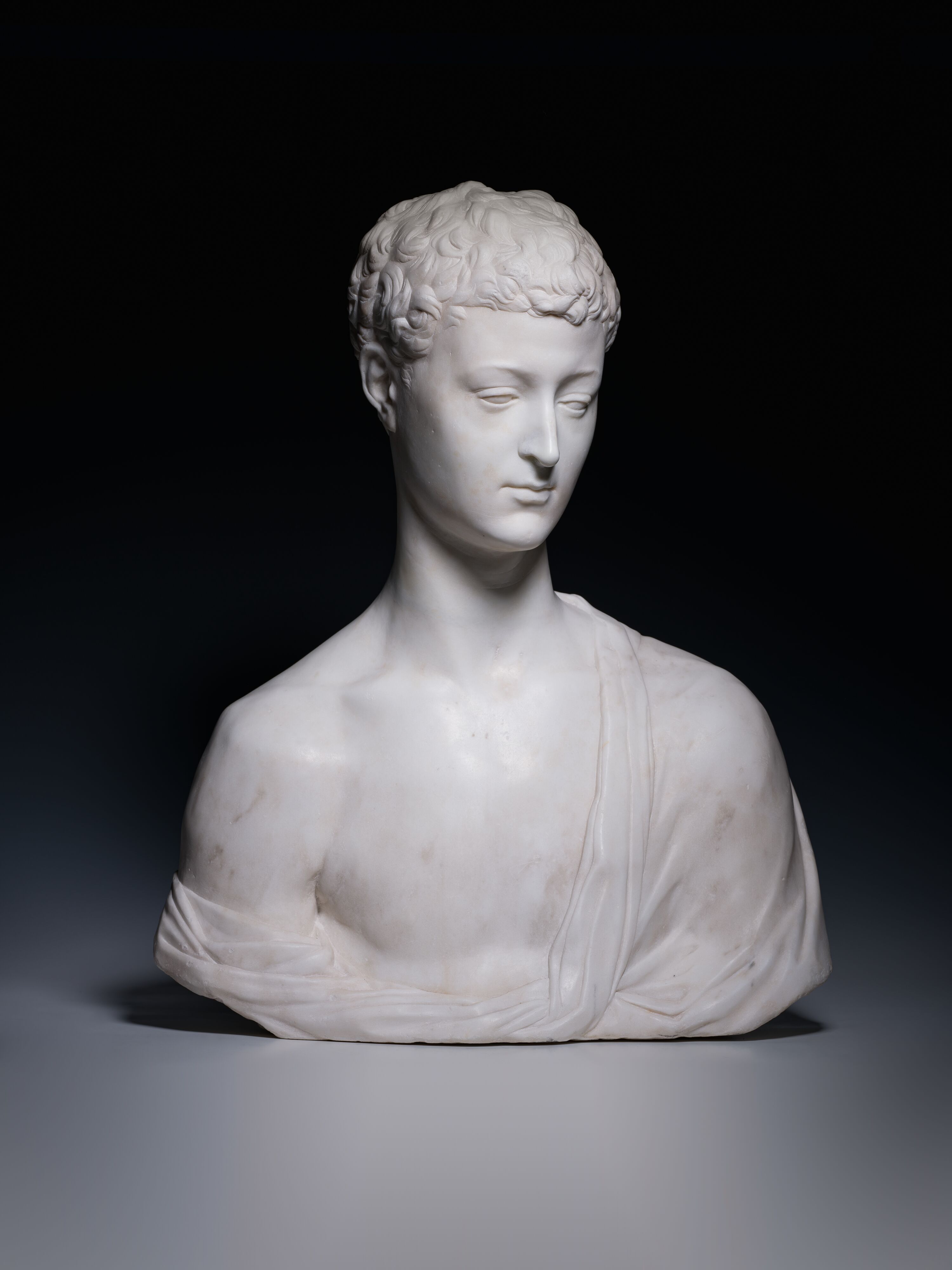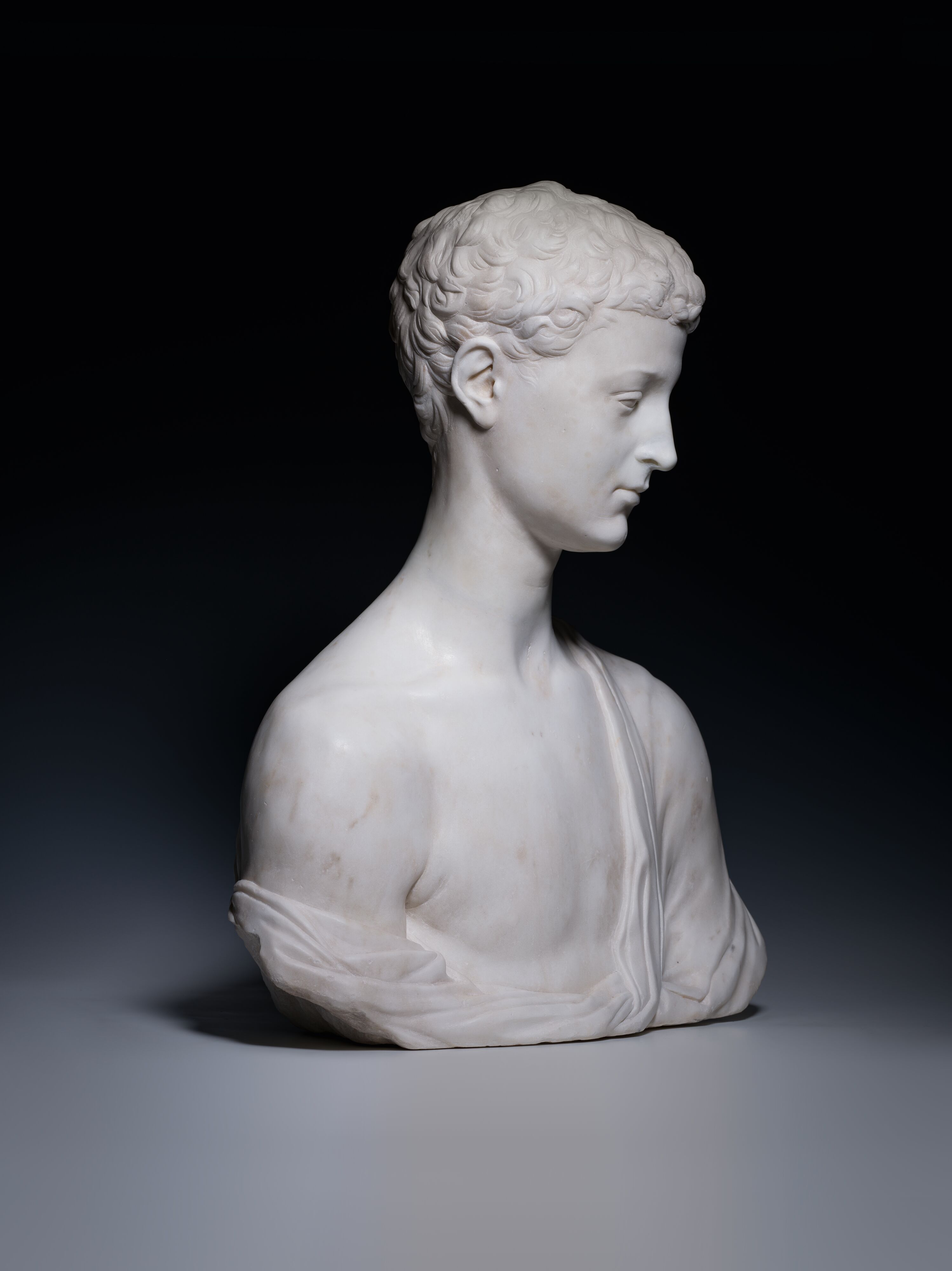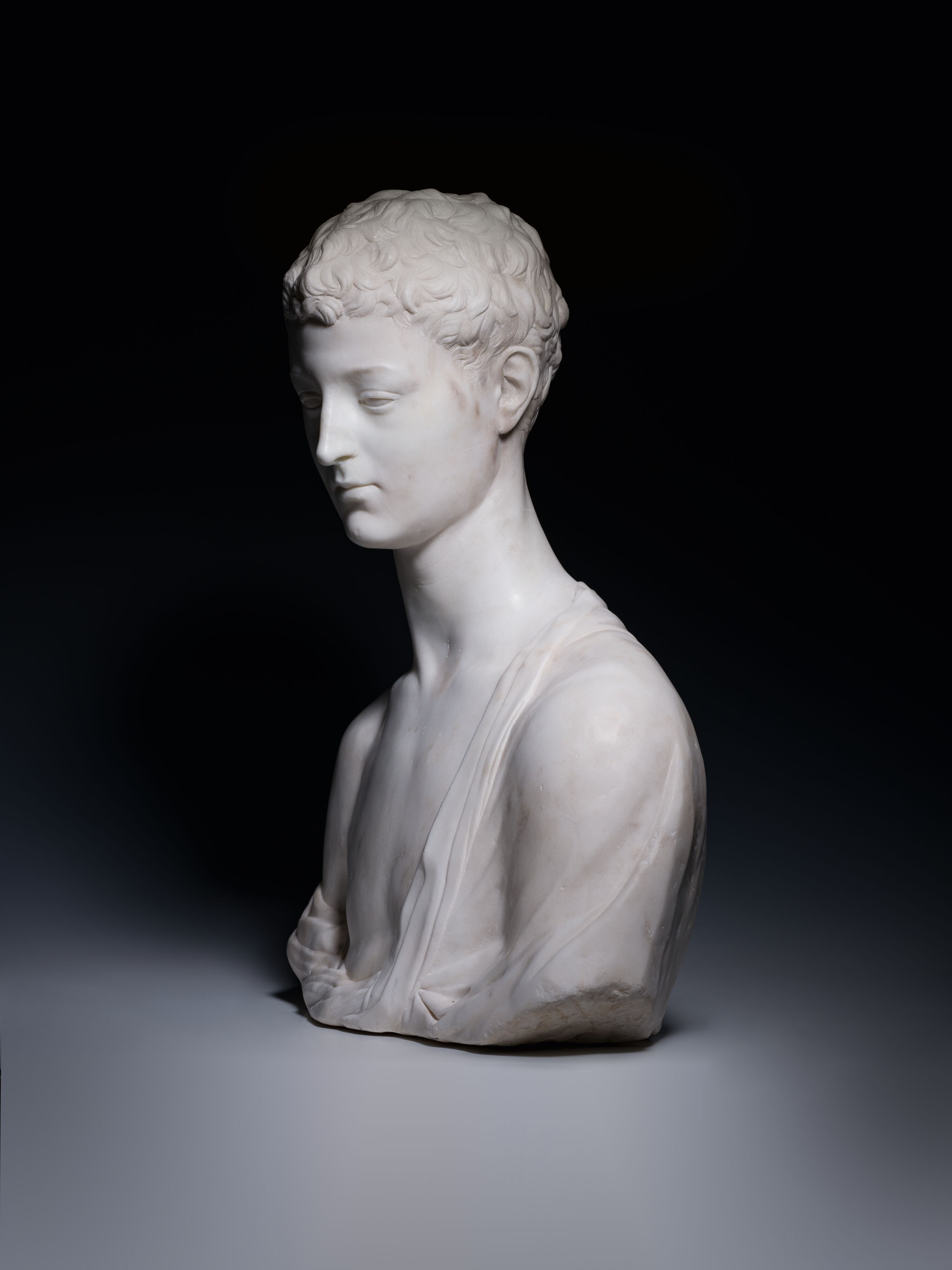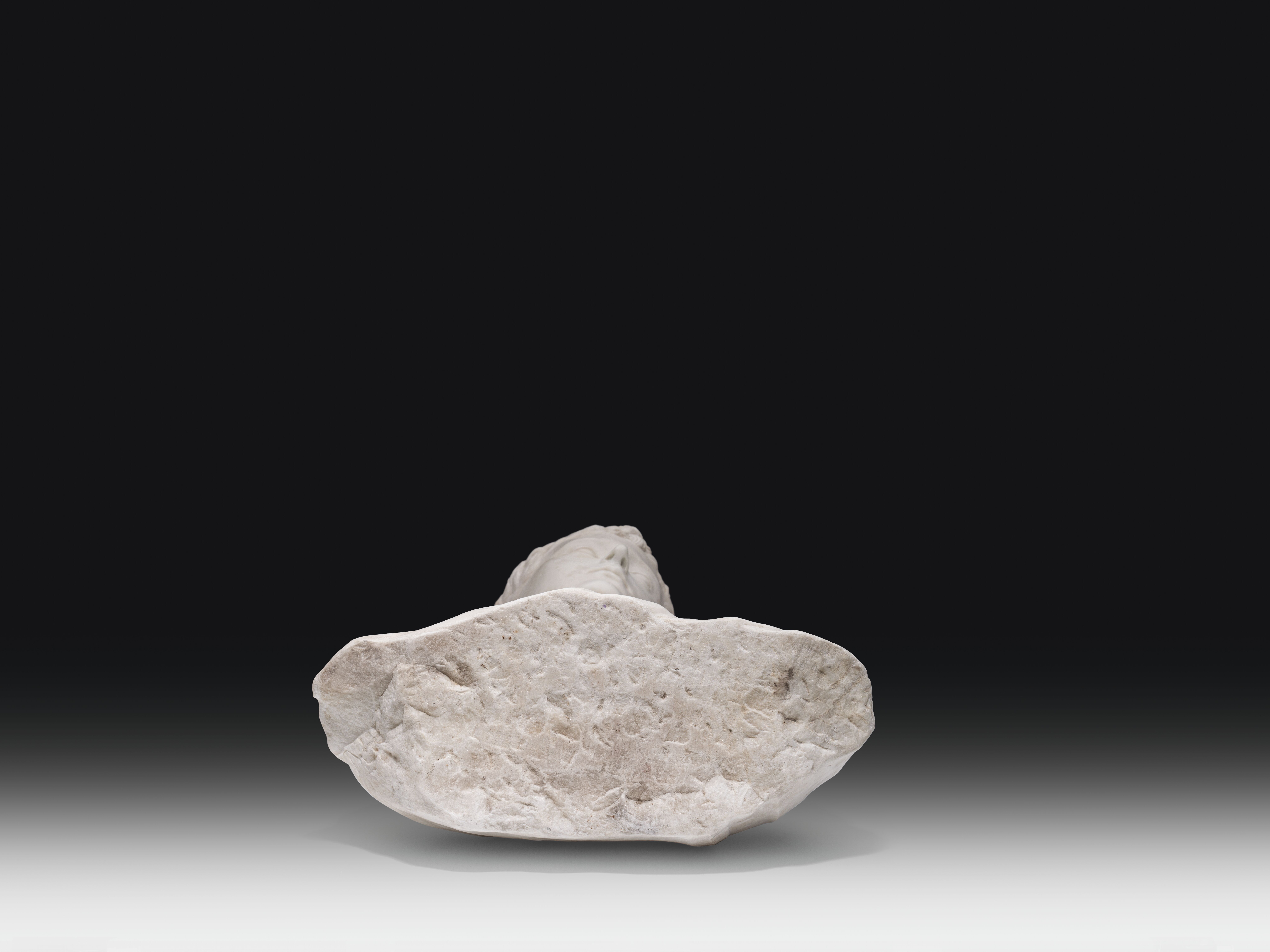1029
Circle of Desiderio da Settignano Bust of a young man (John the Baptist?)marbleh. 59 cm(according to
Bust of a young man (John the Baptist?)
marble
h. 59 cm
(according to family tradition):
since the 1920s private family property, Austria;
since 2016 in the posession of current owner by inheritance
The bust, which has been in private hands in Austria for several generations, is impressive at first glance for its strength and expressiveness. The touching depiction of a young man was probably last given conservational attention in the 19th century. Now that it has been carefully cleaned and restored, its very specific sculptural qualities are even more perceptible. It refers to the exquisite circle of early busts made of stone created in the 15th century in and around the artistic Renaissance centre of Florence.
The depiction of a young man is particularly close to the work of Desiderio da Settignano and his very distinctive canon of forms. The artist is one of the most enigmatic sculptors of the early Renaissance: born in Settignano, near Florence, into a family of local stonemasons; died in Florence, where he had joined the guild of carpenters and stonemasons in 1453. Only three large, free-standing figures can be associated with the sculptor, including the Martelli "Youthful St John the Baptist" (Museo Nazionale del Bargello, Florence, inv. no. 435), which in the past has repeatedly been attributed to Donatello (c. 1386-1466) and has even been discussed as a joint work by the artists.
Desiderio da Settignano is considered one of the outstanding masters in the sphere of influence of the great sculptor, Donatello, who has shaped the concept of Renaissance sculpture per se to this day. He is also documented as the inventor of the new genre of child busts. For example, small-format busts of boys which, as ideal representations of infant Jesus and John the Baptist, were intended above all to encourage the next generation to behave virtuously by identifying with the sacred role models - so it is not surprising that this bust, according to family tradition, was also regarded as a representation of the youthful John the Baptist.
With these exceptionally vivid busts, Desiderio da Settignano created the earliest boy portraits of the Renaissance, which convey to us the subject's state of mind in a very immediate, direct and natural way. The artist concentrates here exclusively on capturing and characterizing the expression of the subjects - the rendering of details becomes secondary.
In the bust presented here, too, the artist is concerned with depicting the proud posture of the young man. Everything that could be distracting is pushed into the background, such as the garment, or is omitted entirely, like a possible headdress. The reproduction of the collarbones, for example, is of particular importance and thus focuses on the volume of the body.
Donatello as well as Desiderio da Settignano are considered to be formative for their work and today's reception of the Florentine Renaissance. Due to the lack of contemporary sources, as well as the change of ownership over the centuries, which is only documented in exceptional cases, clear attributions of artists are rare, even in museum collections. This applies all the more to the artists working in Settignano at the same time and developing in the shadow of the great genius Donatello - such as Desiderio's brother, Geri (1424-c. 1470), who also grew up in their father's stonemasonry workshop, Giuliano da Maiano (1432-1490), Antonio (1427-1479) and Bernardo Rossellino (1407/1410-1464), as well as Francesco di Simone Ferrucci (1437-1493), Desiderio's most important pupil.
Among the most beautiful of these small-format works in this artistic-elitist context are, for example, Desiderio da Settignano's "Laughing Boy" (Kunsthistorisches Museum, Vienna, Inv.-Nr.: Kunstkammer, 9104, cf. fig, 2) and the work identified as "Christ Child" (National Gallery of Art, Washington, Inv.-Nr. 1943.4.94), both dating from the early to mid-1460s. Antonio Rosselino's (1427-1479) "The Young Saint John the Baptist" (National Gallery of Art, Washington, inv.-no. 1943.4.79, figs. 1 & 3) should also be mentioned here as a stylistic parallel.
Büste eines jungen Mannes (Johannes der Täufer ?)
Marmor
H. 59 cm
(laut Familienüberlieferung):
seit den 1920er Jahren in österreichischem Familienbesitz;
seit 2016 durch Erbschaft im Besitz des derzeitigen Eigentümers
Die seit mehreren Generationen in österreichischem Privatbesitz befindliche Büste besticht auf den ersten Blick durch ihre Ausdrucksstärke und Kraft. Der berührenden Darstellung eines jungen Mannes wurde wohl letztmalig im 19. Jahrhundert konservatorische Beachtung geschenkt. Durch die nun kürzlich erfolgte sorgfältige Reinigung und Restaurierung sind ihre sehr spezifischen plastischen Qualitäten noch viel deutlicher lesbar. Sie verweist auf den erlesenen Kreis der frühen Büsten in Stein, die im 15. Jahrhundert in und um das künstlerische Renaissance-Zentrum Florenz entstanden sind.
Besonders nahe steht die Darstellung eines jungen Mannes dem Werk Desiderio da Settignanos und seines sehr ausgeprägten Formenkanons. Der Künstler ist einer der rätselhaftesten Bildhauer der Frührenaissance: geboren in Settignano bei Florenz in eine dort ansässige Familie von Steinmetzen; gestorben in Florenz, wo er 1453 der Zunft der Zimmerleute und Steinmetze beigetreten war. Nur drei große, freistehende Figuren lassen sich mit dem Bildhauer in Verbindung bringen, darunter die Skulptur "Johannes der Täufer von Martelli" (Museo Nazionale del Bargello, Florenz, Inv.-Nr. 435), welche in der Vergangenheit immer wieder auch Donatello (um 1386-1466) zugeschrieben wurde und sogar als Gemeinschaftswerk der Künstler diskutiert wird.
Als einer der herausragenden Meister im Einflussbereich des großen, bis heute den Begriff der Renaissance-Skulptur per se prägenden Bildhauers, Donatello, gilt Desiderio da Settignano. Er ist des Weiteren auch als Erfinder des neuen Genres der Kinderbüsten dokumentiert. Beispielsweise kleinformatige Knabenbüsten, welche als ideale Darstellungen des Christuskindes und Johannes des Täufers vor allem die nachfolgende Generation durch die Identifikation mit den heiligen Vorbildern zu tugendhaftem Verhalten anregen sollten – so überrascht es nicht, dass auch die vorliegende Büste der Familienüberlieferung nach als Darstellung des jugendlichen Johannes des Täufers galt.
Desiderio da Settignano schuf mit diesen außergewöhnlich lebendigen Büsten die frühesten Knabenporträts der Renaissance, die uns den Gemütszustand der Dargestellten auf ganz unmittelbare, direkte und natürliche Weise vermitteln. Der Künstler konzentriert sich hier ausschließlich darauf, den Ausdruck der Dargestellten festzuhalten und zu charakterisieren – die Wiedergabe der Details wird dabei untergeordnet.
Auch bei der hier vorliegenden Büste geht es dem Künstler um die Darstellung der stolzen Haltung des jungen Mannes. Alles, das ablenken könnte ist in den Hintergrund gedrängt, wie das Kleidungsstück, oder wird, wie eine mögliche Kopfbedeckung, zur Gänze weggelassen. So kommt beispielsweise der Wiedergabe der Schlüsselbeine besondere Bedeutung zu und fokussiert damit auf das Volumen des Körpers.
Donatello und ebenso Desiderio da Settignano gelten als stilprägend für ihr Schaffen und die heutige Rezeption der Florentiner Renaissance. Aufgrund mangelnder zeitgenössischer Quellen, sowie die nur in Ausnahmefällen dokumentierten Besitzerwechsel über Jahrhunderte hinweg sind eindeutige Künstler-Zuordnungen selbst in musealen Sammlungen rar. Dies gilt umso mehr für die zur selben Zeit in Settignano arbeitenden und sich im Schatten des großen Genies Donatello entwickelnden Künstler – so unter anderem der Bruder Desiderios, Geri (1424-um 1470), der ebenfalls in der Steinmetzwerkstätte ihres Vaters groß geworden ist, Giuliano da Maiano (1432-1490), Antonio (1427-1479) und Bernardo Rossellino (1407/1410–1464) sowie Francesco di Simone Ferrucci (1437–1493), der wichtigste Schüler Desiderios.
Zu den schönsten unter diesen kleinformatigen Arbeiten in diesem künstlerisch-elitären Kontext zählen beispielsweise Desiderio da Settignanos beide Anfang bis Mitte der 1460er Jahre zu datierenden Werke "Lachender Knabe" (Kunsthistorisches Museum, Wien, Inv.-Nr.: Kunstkammer, 9104, vgl. Abb, 2) und das als "Christuskind" identifizierte Werk (National Gallery of Art, Washington, Inv.-Nr. 1943.4.94). Auch Antonio Rosselinos (1427-1479) "Büste Johannes des Täufers" (National Gallery of Art, Washington, Inv.-Nr. 1943.4.79, Abb. 1 & 3) ist hier als stilistische Parallele zu nennen.
Bust of a young man (John the Baptist?)
marble
h. 59 cm
(according to family tradition):
since the 1920s private family property, Austria;
since 2016 in the posession of current owner by inheritance
The bust, which has been in private hands in Austria for several generations, is impressive at first glance for its strength and expressiveness. The touching depiction of a young man was probably last given conservational attention in the 19th century. Now that it has been carefully cleaned and restored, its very specific sculptural qualities are even more perceptible. It refers to the exquisite circle of early busts made of stone created in the 15th century in and around the artistic Renaissance centre of Florence.
The depiction of a young man is particularly close to the work of Desiderio da Settignano and his very distinctive canon of forms. The artist is one of the most enigmatic sculptors of the early Renaissance: born in Settignano, near Florence, into a family of local stonemasons; died in Florence, where he had joined the guild of carpenters and stonemasons in 1453. Only three large, free-standing figures can be associated with the sculptor, including the Martelli "Youthful St John the Baptist" (Museo Nazionale del Bargello, Florence, inv. no. 435), which in the past has repeatedly been attributed to Donatello (c. 1386-1466) and has even been discussed as a joint work by the artists.
Desiderio da Settignano is considered one of the outstanding masters in the sphere of influence of the great sculptor, Donatello, who has shaped the concept of Renaissance sculpture per se to this day. He is also documented as the inventor of the new genre of child busts. For example, small-format busts of boys which, as ideal representations of infant Jesus and John the Baptist, were intended above all to encourage the next generation to behave virtuously by identifying with the sacred role models - so it is not surprising that this bust, according to family tradition, was also regarded as a representation of the youthful John the Baptist.
With these exceptionally vivid busts, Desiderio da Settignano created the earliest boy portraits of the Renaissance, which convey to us the subject's state of mind in a very immediate, direct and natural way. The artist concentrates here exclusively on capturing and characterizing the expression of the subjects - the rendering of details becomes secondary.
In the bust presented here, too, the artist is concerned with depicting the proud posture of the young man. Everything that could be distracting is pushed into the background, such as the garment, or is omitted entirely, like a possible headdress. The reproduction of the collarbones, for example, is of particular importance and thus focuses on the volume of the body.
Donatello as well as Desiderio da Settignano are considered to be formative for their work and today's reception of the Florentine Renaissance. Due to the lack of contemporary sources, as well as the change of ownership over the centuries, which is only documented in exceptional cases, clear attributions of artists are rare, even in museum collections. This applies all the more to the artists working in Settignano at the same time and developing in the shadow of the great genius Donatello - such as Desiderio's brother, Geri (1424-c. 1470), who also grew up in their father's stonemasonry workshop, Giuliano da Maiano (1432-1490), Antonio (1427-1479) and Bernardo Rossellino (1407/1410-1464), as well as Francesco di Simone Ferrucci (1437-1493), Desiderio's most important pupil.
Among the most beautiful of these small-format works in this artistic-elitist context are, for example, Desiderio da Settignano's "Laughing Boy" (Kunsthistorisches Museum, Vienna, Inv.-Nr.: Kunstkammer, 9104, cf. fig, 2) and the work identified as "Christ Child" (National Gallery of Art, Washington, Inv.-Nr. 1943.4.94), both dating from the early to mid-1460s. Antonio Rosselino's (1427-1479) "The Young Saint John the Baptist" (National Gallery of Art, Washington, inv.-no. 1943.4.79, figs. 1 & 3) should also be mentioned here as a stylistic parallel.
Büste eines jungen Mannes (Johannes der Täufer ?)
Marmor
H. 59 cm
(laut Familienüberlieferung):
seit den 1920er Jahren in österreichischem Familienbesitz;
seit 2016 durch Erbschaft im Besitz des derzeitigen Eigentümers
Die seit mehreren Generationen in österreichischem Privatbesitz befindliche Büste besticht auf den ersten Blick durch ihre Ausdrucksstärke und Kraft. Der berührenden Darstellung eines jungen Mannes wurde wohl letztmalig im 19. Jahrhundert konservatorische Beachtung geschenkt. Durch die nun kürzlich erfolgte sorgfältige Reinigung und Restaurierung sind ihre sehr spezifischen plastischen Qualitäten noch viel deutlicher lesbar. Sie verweist auf den erlesenen Kreis der frühen Büsten in Stein, die im 15. Jahrhundert in und um das künstlerische Renaissance-Zentrum Florenz entstanden sind.
Besonders nahe steht die Darstellung eines jungen Mannes dem Werk Desiderio da Settignanos und seines sehr ausgeprägten Formenkanons. Der Künstler ist einer der rätselhaftesten Bildhauer der Frührenaissance: geboren in Settignano bei Florenz in eine dort ansässige Familie von Steinmetzen; gestorben in Florenz, wo er 1453 der Zunft der Zimmerleute und Steinmetze beigetreten war. Nur drei große, freistehende Figuren lassen sich mit dem Bildhauer in Verbindung bringen, darunter die Skulptur "Johannes der Täufer von Martelli" (Museo Nazionale del Bargello, Florenz, Inv.-Nr. 435), welche in der Vergangenheit immer wieder auch Donatello (um 1386-1466) zugeschrieben wurde und sogar als Gemeinschaftswerk der Künstler diskutiert wird.
Als einer der herausragenden Meister im Einflussbereich des großen, bis heute den Begriff der Renaissance-Skulptur per se prägenden Bildhauers, Donatello, gilt Desiderio da Settignano. Er ist des Weiteren auch als Erfinder des neuen Genres der Kinderbüsten dokumentiert. Beispielsweise kleinformatige Knabenbüsten, welche als ideale Darstellungen des Christuskindes und Johannes des Täufers vor allem die nachfolgende Generation durch die Identifikation mit den heiligen Vorbildern zu tugendhaftem Verhalten anregen sollten – so überrascht es nicht, dass auch die vorliegende Büste der Familienüberlieferung nach als Darstellung des jugendlichen Johannes des Täufers galt.
Desiderio da Settignano schuf mit diesen außergewöhnlich lebendigen Büsten die frühesten Knabenporträts der Renaissance, die uns den Gemütszustand der Dargestellten auf ganz unmittelbare, direkte und natürliche Weise vermitteln. Der Künstler konzentriert sich hier ausschließlich darauf, den Ausdruck der Dargestellten festzuhalten und zu charakterisieren – die Wiedergabe der Details wird dabei untergeordnet.
Auch bei der hier vorliegenden Büste geht es dem Künstler um die Darstellung der stolzen Haltung des jungen Mannes. Alles, das ablenken könnte ist in den Hintergrund gedrängt, wie das Kleidungsstück, oder wird, wie eine mögliche Kopfbedeckung, zur Gänze weggelassen. So kommt beispielsweise der Wiedergabe der Schlüsselbeine besondere Bedeutung zu und fokussiert damit auf das Volumen des Körpers.
Donatello und ebenso Desiderio da Settignano gelten als stilprägend für ihr Schaffen und die heutige Rezeption der Florentiner Renaissance. Aufgrund mangelnder zeitgenössischer Quellen, sowie die nur in Ausnahmefällen dokumentierten Besitzerwechsel über Jahrhunderte hinweg sind eindeutige Künstler-Zuordnungen selbst in musealen Sammlungen rar. Dies gilt umso mehr für die zur selben Zeit in Settignano arbeitenden und sich im Schatten des großen Genies Donatello entwickelnden Künstler – so unter anderem der Bruder Desiderios, Geri (1424-um 1470), der ebenfalls in der Steinmetzwerkstätte ihres Vaters groß geworden ist, Giuliano da Maiano (1432-1490), Antonio (1427-1479) und Bernardo Rossellino (1407/1410–1464) sowie Francesco di Simone Ferrucci (1437–1493), der wichtigste Schüler Desiderios.
Zu den schönsten unter diesen kleinformatigen Arbeiten in diesem künstlerisch-elitären Kontext zählen beispielsweise Desiderio da Settignanos beide Anfang bis Mitte der 1460er Jahre zu datierenden Werke "Lachender Knabe" (Kunsthistorisches Museum, Wien, Inv.-Nr.: Kunstkammer, 9104, vgl. Abb, 2) und das als "Christuskind" identifizierte Werk (National Gallery of Art, Washington, Inv.-Nr. 1943.4.94). Auch Antonio Rosselinos (1427-1479) "Büste Johannes des Täufers" (National Gallery of Art, Washington, Inv.-Nr. 1943.4.79, Abb. 1 & 3) ist hier als stilistische Parallele zu nennen.
Große Jubiläumsauktion: Day Sale
Sale Date(s)
Venue Address
General delivery information available from the auctioneer
If you do not wish to collect your pieces from us yourself, we will arrange delivery for you. Our specialist business partners are professionals in packing, insurance and delivery and will provide these services at advantageous rates. The after-sales service usually proceeds as follows:If you would like, after the auction our logistics department will give you a quotation for transport and insurance.
If you would like to take advantage of this delivery option, contact the logistics department, after you have paid the purchase price, T +43 1 5324200-18 or r.mayr@imkinsky.com
When you place your order, your details will be sent to the appropriate shipping company. You will be contacted by our business partner to arrange a delivery date.
The price for transport and insurance is arranged directly with the shipping company.
If you don’t want to take advantage of this service, we must ask you to arrange collection yourself. We ask for your understanding that in this case we can take no responsibility for the quality of packing or transportation and can therefore take no responsibility for whether your pieces arrive intact.
Important Information
Exhibition 17-30 November
Mon-Fri 10am-6pm
Sat & Sun 10am-5pm
Terms & Conditions
Conditions of Auction
Extract from the rules of procedure
The wording of the complete rules of procedure can be viewed on our homepage www.imkinsky.com. By request we will also send the rules of procedure to you.
• Rules of Business: Auctions are conducted according to the conditions of sale as set down by Auktionshaus im Kinsky GmbH. The rules of business are available for viewing at the Auction House, and can be requested by post or email (office@imkinsky.com), they can also be called up on the internet under www.imkinsky.com.
• Estimates: In the catalogues the lower and upper estimated values are indicated and represent the approximate bid expectations of the responsible experts.
• Reserves (Limits): Sellers quite often appoint the auction house, not to sell their objects beneath certain price. These prices (= reserve/limit) usually match the lower estimate, but in special situations can also surpass them.
• Guarantee of Authenticity: The valuation, as well as technical classification and description of the art objects is carried out by the specialists of Auktionshaus im Kinsky. Auktionshaus im Kinsky guarantees the purchaser the authenticity for three years – i.e. that the authorship of the art object is as set out in the catalogue.
• Catalogue Descriptions: Catalogue information concerning techniques, signatures, materials, condition, provenance, period of origin or manufacture etc. are based on the current knowledge determined by the experts. Auktionshaus im Kinsky cannot be held responsible for the verification of these descriptions.
• Insurance: All the art objects are insured. The insurance value is the purchase price. The responsibility of the Auction House lasts until the eighth day after the auction. After that, each art object is only insured if there is an order from the purchaser to do so.
• Starting price & Hammer price: The starting price is determined by the auctioneer. The bidding rises in approximate increments of 10 % from the starting price, or from the last bid. The highest bidder acknowledged by the auctioneer will be the purchaser as long as it has reached the minimum price (reserve).
• Buyer’s Premium: For art objects which require ‘difference’ taxation the purchase price consists of the hammer price plus the sales commission of 26 %. For art objects which require ‘normal’ taxation (marked with ▲), the price consists of the hammer price plus commission of 22 %, plus VAT (13 % for paintings, 20 % for antiques). For hammer price in excess of € 300,000 we will charge a commission of 17 % (margin taxation) or 14 % (normal taxation).
• Droit de suite: Objects marked with an asterisk* in the catalogue are subject to droit de suite in addition to the purchase price. Droit de suite is calculated as a percentage of the highest bid as follows: 4 % of the first € 50,000, 3 % of the next € 150,000, 1 % of the next € 150,000, 0.5 % of the next € 150,000 and 0.25 % of the remaining amount (i.e. over € 500,000), but not exceeding a total sum of € 12,500. Droit de suite does not apply to highest bids below € 2,500.
• Absentee bids: Clients can also submit written absentee bids or bid themselves over the phone, or give an order to the broker. To do so Auktionshaus im Kinsky must have received signed order forms, (available in the catalogues), in due time.
• Telephone bids: We will do our best to establish a telephone link, but we cannot warrant for such a telephone connection.
• Online Bidding: Interested parties can participate in the auction also via the Internet. The regulations of Auktionshaus im Kinsky shall be applicable. Auktionshaus im Kinsky assumes no liability for any breakdown or loss of the Internet connection.
• Governing Law and jurisdiction: The site for the dealings between Auktionshaus im Kinsky and the purchaser is the address of Auktionshaus im Kinsky. All legal dealings or conflicts between persons involved in the auctions are governed by Austrian Law, place of jurisdiction shall be the Courts for the First District of Vienna.
Auktionsbedingungen
Auszug aus der Geschäftsordnung
Den Wortlaut der gesamten Geschäftsordnung können Sie unserer Homepage www.imkinsky.com entnehmen. Auf Wunsch senden wir Ihnen die Geschäftsordnung auch zu.
•Geschäftsordnung: Die Auktion wird nach den Bestimmungen der Geschäftsordnung der Auktionshaus im Kinsky GmbH durchgeführt. Die Geschäftsordnung liegt im Auktionshaus zur Einsicht auf, kann von jedermann per Post oder E-mail (office@imkinsky.com) angefordert werden und ist im Internet unter www.imkinsky.com abrufbar.
•Schätzpreise: Im Katalog sind untere und obere Schätzwerte angegeben. Sie stellen die Meistboterwartungen der zuständigen Experten dar.
•Mindestverkaufspreise (Limits): Oft beauftragen Verkäufer das Auktionshaus, die ihnen gehörenden Kunstwerke nicht unter bestimmten (Mindest-)Verkaufspreisen zuzuschlagen. Diese Preise (= „Limits“) entsprechen meist den in den Katalogen angegebenen unteren Schätzwerten, sie können aber fallweise auch darüber liegen.
•Echtheitsgarantie: Die Schätzung, fachliche Bestimmung und Beschreibung der Kunstobjekte erfolgt durch Experten des Auktionshauses-. Das Auktionshaus steht innerhalb von drei Jahren gegenüber dem Käufer für die Echtheit und somit dafür ein, dass ein Kunstobjekt tatsächlich von dem im Katalog genannten Künstler stammt.
•Katalogangaben: Angaben über Technik, Signatur, Material, Zustand, Provenienz, Epoche der Entstehung usw. beruhen auf aktuellen wissenschaftlichen Erkenntnissen, die die Experten ausgeforscht haben. Das Auktionshaus leistet jedoch für die Richtigkeit dieser Angaben gegenüber keine Gewähr.
•Versicherung: Die Kunstobjekte sind versichert. Versicherungswert ist der Kaufpreis. Die Haftung des Auktionshauses besteht bis zu dem auf die Auktion folgenden 8. Tag. Danach ist ein Kunstobjekt nur versichert, wenn der Käufer dies dem Auktionshaus aufgetragen hat.
•Ausrufpreis und Zuschlag: Der Ausrufpreis wird vom Auktionator festgesetzt. Gesteigert wird um ca. 10 % des Ausrufpreises bzw. vom letzten Angebot aus-gehend. Den Zuschlag erhält der Meistbietende, sofern der Mindestverkaufspreis erreicht ist. Der Käufer hat den Kaufpreis binnen 8 Tagen nach dem Zuschlag zu bezahlen.
•Kaufpreis: Bei Kunstobjekten, die der Differenzbesteuerung unterliegen, besteht der Kaufpreis aus dem Meistbot zuzüglich der Käuferprovision von 26 %. Bei Kunstobjekten, die der Normalbesteuerung (mit ▲ gekennzeichnet) unterliegen, besteht der Kaufpreis aus dem Meistbot zuzüglich der Käuferprovision von 22 % und zuzüglich der Umsatzsteuer (13 % bei Bildern, 20 % bei Antiquitäten). Bei € 300.000 übersteigenden Meistboten wird eine Käuferprovision von 17 % (Differenzbesteuerung) bzw. 14 % (Normalbesteuerung) verrechnet.
•Folgerecht: Bei Kunstobjekten, die im Katalog mit einem * gekennzeichnet sind, wird zusätzlich zum Kaufpreis die Folgerechtsabgabe verrechnet. Sie beträgt 4 % von den ersten € 50.000 des Meistbotes, 3 % von den weiteren € 150.000, 1 % von den weiteren € 150.000, 0,5 % von den weiteren € 150.000 und 0,25 % von allen weiteren, also € 500.000 übersteigenden Meistboten, jedoch insgesamt nicht mehr als € 12.500. Bei Meistboten von weniger als € 2.500 entfällt die Folgerechtsabgabe.
•Kaufaufträge: Interessenten können auch schriftliche Kaufaufträge abgeben oder telefonisch mitbieten oder den Sensal mit dem Mitbieten beauftragen. Dafür muss dem Auktionshaus zeitgerecht das unterfertigte, dem Katalog bei-liegende Kaufauftragsformular übersandt worden sein.
•Telefonische Gebote: Das Auktionshaus wird unter der ihm bekanntgegebenen Nummer eine Verbindung herzustellen trachten. Für das Zustandekommen einer Verbindung übernimmt das Auktionshaus keine Haftung.
•Online Bidding: Interessenten können an Auktionen auch über das Internet teilnehmen. Die Bestimmungen über die unmittelbare Teilnahme an Auktionsveranstaltungen gelten hierfür sinngemäß. Für das Zustandekommen einer Internetverbindung übernimmt das Auktionshaus keine Haftung.
• Gerichtsstand, Rechtswahl: Die zwischen allen an der Auktion Beteiligten bestehenden Rechtsbeziehungen unterliegen österreichischem materiellem Recht. Als Gerichtsstand wird das für den 1. Wiener Gemeindebezirk örtlich zuständige Gericht vereinbart.















